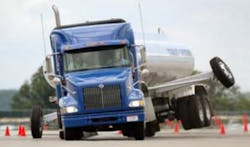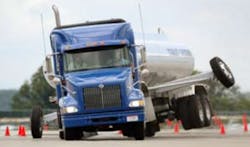NHTSA releases electronic stability control mandate for Class 7-8 tractors
Transportation Secretary Anthony Foxx made it official Wednesday: Electronic stability control (ESC) systems will be required on large trucks and buses beginning in 2017.
But it’s no surprise to the industry. The National Highway Traffic Safety Administration (NHTSA) has been officially working on the rule for more than three years, following direction from Congress in MAP-21, the federal highway bill. And the technology has been available, though not required, on commercial vehicles for a decade.
“ESC is a remarkable safety success story, a technology innovation that is already saving lives in cars and light trucks,” Foxx said. “Requiring ESC on heavy trucks and large buses will bring that safety innovation to the largest vehicles on our highways, increasing safety for drivers and passengers of these vehicles and for all road users.”
NHTSA estimates the requirement will save up to 49 lives, prevent up to 1,759 crashes each year, and provide net economic benefits of more than $300 million annually.
American Trucking Assns. (ATA) welcomed the announcement.
“Ensuring the safety of America’s highways has always been ATA’s highest calling,” said ATA President and CEO Bill Graves, “and we’ve long known the positive role technology can play in making our vehicles and our roads safer. Today’s announcement by NHTSA will reduce crashes on our highways and make our industry safer.”
The Owner-Operator Independent Drivers Assn., however, questioned the need for a mandate.
“Too many have become addicted to technology, or more precisely the promise, allure or maybe even the fascination of technology,” said Todd Spencer, OOIDA executive vice president. “While we are by no means opposed to technology, what we have become accustomed to seeing from government mandates is supposed justification that mirror marketing claims. If any of this really improves safety, that should be evident where the rubber meets the road. We simply don't see it in the vast majority of instances.”
The rule estimates the technology will add just under $600 to the cost of a new tractor.Fred Andersky, director of government and industry affairs for Bendix Commercial Vehicle Systems LLC, pointed out in an interview with American Trucker that four truck makers already include ESC as standard equipment, and that the “relatively low” cost for ESC systems could possibly go lower with wider adoption, as with anti-lock braking systems. In 2014, 34% of Class 6-8 air-braked vehicles were built with stability technology, according to Bendix figures.
“Now all new tractors will get the benefit of full-stability technology to help mitigate rollover and loss of control,” Andersky said. “The other benefit is this isn’t a new technology. We’re celebrating 10 years of Bendix ESP (or Electronic Stability Program, the Bendix branded ESC system) commercial availability. So it’s not case of getting a mandate, as with some of the environmental regulations, that could have a major impact on manufacturers. This is just a natural extension of what is already available.”
He also highlighted the importance of a full-stability control mandate, as compared to a more basic roll-only stability system. Full-stability systems use more sensors than either ABS or roll-only stability systems, creating a more comprehensive system capable of addressing both roll and directional stability.
Among surprises in the rule, Andersky noted the absence of a "sine with dwell" maneuvering test requirement—an omission that likely makes the rule “much more acceptable” to OEMs. While mandated for automobiles, the test is a complicated one, challenging to stage and can even be dangerous for heavy trucks, he suggested.
He noted, however, the rule is written in a way that allows NHTSA to beef-up performance requirements in the future, should the anticipated safety benefits not be realized with the current standards. The rule will not require older trucks be retrofit with ESC technology.
Additionally, the phase-in schedule for motorcoaches suggests that NHTSA has left the door open to mandate ESC for the “doughnut hole,” or hydraulically braked Class 3-6 vehicles not currently covered by the rule, according to Andersky.
The mandate is also another step in the advancement of minimum commercial vehicle safety technology requirements. Collision mitigation systems are likely next on the regulator’s agenda, he suggested, then possibly vehicle-to-vehicle communication standards. All of which lead, eventually, to automated vehicle systems—but “it’s not going to happen tomorrow.”
And these are “driver assistance technologies, not driver replacement technologies,” Andersky emphasized.
“The driver is still an integral part of the safety equation. This technology does not take away the responsibility for safe, alert drivers practicing safe driving habits and taking advantage of comprehensive driver training,” he said. “It’s there to help the drivers out—it doesn’t replace them.”
About the Author
Kevin Jones
Editor
Kevin has served as editor-in-chief of Trailer/Body Builders magazine since 2017—just the third editor in the magazine’s 60 years. He is also editorial director for Endeavor Business Media’s Commercial Vehicle group, which includes FleetOwner, Bulk Transporter, Refrigerated Transporter, American Trucker, and Fleet Maintenance magazines and websites.
Working from Beaufort, S.C., Kevin has covered trucking and manufacturing for nearly 20 years. His writing and commentary about the trucking industry and, previously, business and government, has been recognized with numerous state, regional, and national journalism awards.


